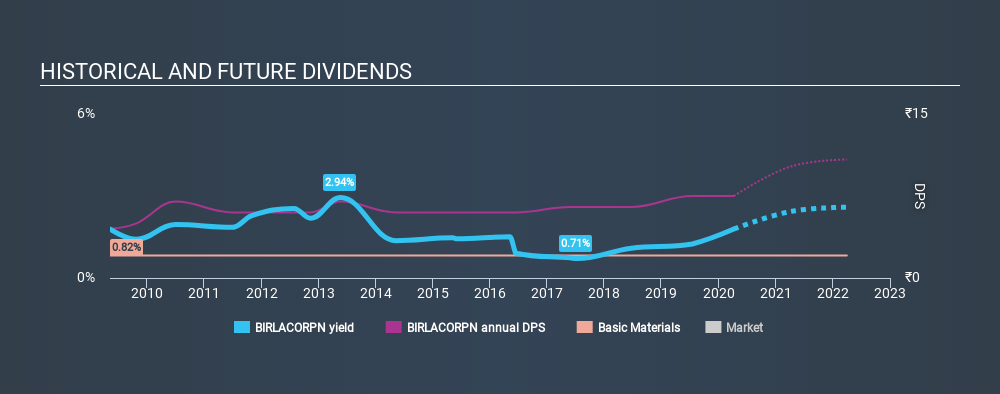- India
- /
- Basic Materials
- /
- NSEI:BIRLACORPN
Birla Corporation Limited's (NSE:BIRLACORPN) Attractive Combination: Does It Earn A Place In Your Dividend Portfolio?

Could Birla Corporation Limited (NSE:BIRLACORPN) be an attractive dividend share to own for the long haul? Investors are often drawn to strong companies with the idea of reinvesting the dividends. If you are hoping to live on the income from dividends, it's important to be a lot more stringent with your investments than the average punter.
A slim 1.8% yield is hard to get excited about, but the long payment history is respectable. At the right price, or with strong growth opportunities, Birla could have potential. Remember that the recent share price drop will make Birla's yield look higher, even though recent events might have impacted the company's prospects. Some simple research can reduce the risk of buying Birla for its dividend - read on to learn more.
Explore this interactive chart for our latest analysis on Birla!

Payout ratios
Dividends are usually paid out of company earnings. If a company is paying more than it earns, then the dividend might become unsustainable - hardly an ideal situation. As a result, we should always investigate whether a company can afford its dividend, measured as a percentage of a company's net income after tax. Looking at the data, we can see that 13% of Birla's profits were paid out as dividends in the last 12 months. We like this low payout ratio, because it implies the dividend is well covered and leaves ample opportunity for reinvestment.
We also measure dividends paid against a company's levered free cash flow, to see if enough cash was generated to cover the dividend. Birla's cash payout ratio last year was 12%, which is quite low and suggests that the dividend was thoroughly covered by cash flow. It's positive to see that Birla's dividend is covered by both profits and cash flow, since this is generally a sign that the dividend is sustainable, and a lower payout ratio usually suggests a greater margin of safety before the dividend gets cut.
Is Birla's Balance Sheet Risky?
As Birla has a meaningful amount of debt, we need to check its balance sheet to see if the company might have debt risks. A quick check of its financial situation can be done with two ratios: net debt divided by EBITDA (earnings before interest, tax, depreciation and amortisation), and net interest cover. Net debt to EBITDA measures total debt load relative to company earnings (lower = less debt), while net interest cover measures the ability to pay interest on the debt (higher = greater ability to pay interest costs). With net debt of 1.84 times its EBITDA, Birla has an acceptable level of debt.
We calculated its interest cover by measuring its earnings before interest and tax (EBIT), and dividing this by the company's net interest expense. Interest cover of 2.75 times its interest expense is starting to become a concern for Birla, and be aware that lenders may place additional restrictions on the company as well.
Consider getting our latest analysis on Birla's financial position here.
Dividend Volatility
From the perspective of an income investor who wants to earn dividends for many years, there is not much point buying a stock if its dividend is regularly cut or is not reliable. For the purpose of this article, we only scrutinise the last decade of Birla's dividend payments. The dividend has been stable over the past 10 years, which is great. We think this could suggest some resilience to the business and its dividends. During the past ten-year period, the first annual payment was ₹4.50 in 2010, compared to ₹7.50 last year. This works out to be a compound annual growth rate (CAGR) of approximately 5.2% a year over that time.
Businesses that can grow their dividends at a decent rate and maintain a stable payout can generate substantial wealth for shareholders over the long term.
Dividend Growth Potential
While dividend payments have been relatively reliable, it would also be nice if earnings per share (EPS) were growing, as this is essential to maintaining the dividend's purchasing power over the long term. It's good to see Birla has been growing its earnings per share at 28% a year over the past five years. Earnings per share have grown rapidly, and the company is retaining a majority of its earnings. We think this is ideal from an investment perspective, if the company is able to reinvest these earnings effectively.
Conclusion
To summarise, shareholders should always check that Birla's dividends are affordable, that its dividend payments are relatively stable, and that it has decent prospects for growing its earnings and dividend. First, we like that the company's dividend payments appear well covered, although the retained capital also needs to be effectively reinvested. That said, we were glad to see it growing earnings and paying a fairly consistent dividend. Overall, we think there are a lot of positives to Birla from a dividend perspective.
Investors generally tend to favour companies with a consistent, stable dividend policy as opposed to those operating an irregular one. Still, investors need to consider a host of other factors, apart from dividend payments, when analysing a company. Just as an example, we've come accross 2 warning signs for Birla you should be aware of, and 1 of them shouldn't be ignored.
Looking for more high-yielding dividend ideas? Try our curated list of dividend stocks with a yield above 3%.
If you spot an error that warrants correction, please contact the editor at editorial-team@simplywallst.com. This article by Simply Wall St is general in nature. It does not constitute a recommendation to buy or sell any stock, and does not take account of your objectives, or your financial situation. Simply Wall St has no position in the stocks mentioned.
We aim to bring you long-term focused research analysis driven by fundamental data. Note that our analysis may not factor in the latest price-sensitive company announcements or qualitative material. Thank you for reading.
About NSEI:BIRLACORPN
Birla
Manufactures and sells cement and clinker in India and internationally.
Adequate balance sheet average dividend payer.
Similar Companies
Market Insights
Community Narratives



